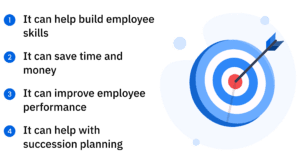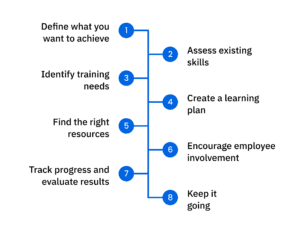Eight steps for developing employees’ skills
In this article, we discuss the use of training management software and offer a detailed guide with eight steps to help develop employees’ skills effectively.

As the workplace continues to evolve, the skills of the person occupying it must grow as well. A recent survey found that 96% of employees are interested in cultivating new skills. This is an opportunity for learning and development (L&D) managers to improve their employees’ capabilities by creating skill development pathways that focus on critical competencies and match organizational objectives. L&D managers can help employees excel in their current roles and prepare them for future challenges. They can close existing skill gaps and create a more engaged and productive workforce. This article discusses how training management software can help employees acquire new skills.
What is training management software?Copied
Training management software helps organizations plan, deliver, and track employee training.
It also measures the impact of training on employee performance and assesses whether employees have the required skill sets for their roles.
By using this software, L&D managers can streamline the creation and delivery of training programs, which saves their organization time and money while ensuring the best learning experience for their employees.
Why use training management software?Copied

There are many reasons why organizations should consider using training management software. The most important are:
1. It can help build employee skills: By creating training programs that focus on critical competencies and organizational objectives, L&D managers can help their employees excel in their current roles and prepare them for future challenges.
This can close existing skill gaps and create a more engaged and productive workforce.
2. It can save time and money: Training management software can help L&D managers streamline the creation and delivery of training programs.
This can save their organization time and money while ensuring that their employees receive the best learning experience.
3. It can improve employee performance: By using training management software, organizations can measure the impact of training on employee performance.
The results show whether their employees have the required skills for their roles, and they identify areas where additional training may be needed.
4. It can help with succession planning: Training management software can be used to identify high-potential employees and create development plans that focus on their anticipated future competencies.
This can help organizations prepare for leadership changes and ensure that the most qualified people are selected to meet future challenges.
What should every manager know about training?Copied
As a manager, you are responsible for employing people with the necessary skills and knowledge for effective job performance. But what can you do if your team members don’t have the core skills they need?
In that case, you need to provide your employees with the opportunity to learn new skills, brush up on existing ones, and stay up-to-date on changes in your industry. It can be challenging to find the right training and get the most out of your training budget.
It is therefore essential to choose programs that are relevant to your business and aligned with your goals. Furthermore, you need to ensure that your employees participate in the training and apply the acquired knowledge at their workplace. Training management software can help you track employee training and monitor progress.
Eight steps for developing employees’ skills with training management softwareCopied

To help you get started, here are eight steps to developing your employees’ skills:
1. Define what you want to achieve
The first step in any employee development program is defining the goals and objectives. Which skills do you want your employees to develop? What are the critical competencies for success in your organization?
When setting goals for your employee development program, it is vital to ensure that they are realistic and achievable.
If employees feel that these goals are too difficult or impossible to achieve, they will likely become discouraged and may even exit the program. Training management software can help you track progress and measure success
2. Assess existing skills
Before developing a plan to improve their skills, you need to assess what your team members currently know and are capable of. This information can be gathered through interviews, surveys, and observations.
3. Identify training needs
After you have assessed their existing skills, you can identify areas where additional training may be needed. Ask your employees which training they would benefit from and match it with your organizational goals and objectives.
4. Create a learning plan
Create a learning plan that outlines the steps needed to achieve these goals. The plan should include a mix of formal and informal learning activities, such as courses, workshops, and mentorship programs.
Training management software can be used to ensure that learning objectives are being met and resources allocated appropriately.
5. Find the right resources
Find suitable training programs and materials, as well as identify mentors and coaches who can provide guidance and support that matches your team’s and your organization’s objectives.
6. Encourage employee involvement
The success of any employee development program depends on the willingness of the employees to participate.
Understanding the program’s benefits and how it can help them improve their skills is essential to their involvement.
Additionally, employees should be given space and time to provide feedback on the program to help shape its content.
7. Track progress and evaluate results
Track the program’s impact on your employees’ skills and competencies, as well as on your organization’s overall performance. It is important to evaluate the progress of the program to identify areas of success and areas that need improvement.
8. Keep it going
Employee development should not be a one-time event but rather an ongoing process.
By continuously assessing the needs of your employees and providing targeted training and development opportunities, you can ensure that your employees have the skills and competencies they need to be successful in their roles.
Updating the program occasionally ensures that it remains relevant and responsive to the needs of your organization.
AG5 training management softwareCopied
AG5 software is a comprehensive solution for tracking the skills and competencies of your teams.
The software includes various features that can be used to assess your employees’ skills, identify training needs, track progress, and evaluate results.
Additionally, AG5’s reporting capabilities allow you to generate detailed reports that show the impact of your employee development program.
To learn more about AG5 skills management software, schedule your live remote demo.

